How to Fill Chipmunk Holes the Easy & Humane Way
Author: Chris Miller | Editor: Omar Alonso
Review & Research: Jen Worst & Chris Miller

Are those pesky chipmunks digging holes in your yard? It's time to show them who's boss and evict them from your property. What's the best way to do that? We're going to learn how to fill chipmunk holes. However, you can't just fill them with dirt, or they'll dig them out again.
Fortunately, we have the perfect strategy for filling their holes, ensuring they don't return. With our ideas, the chipmunks have no choice but to vacate your yard and look for alternative accommodations.
Before we start, we want to let you know that we only use humane methods for removing chipmunks. We don't endorse any technique that might harm these animals. Finding chipmunk burrows in your lawn might be annoying, but that doesn't warrant a death sentence for these little critters.
Let's cover some basics first that will help you understand how and why the methods we'll be suggesting are the ones you want to use.
What Do Chipmunk Holes Look Like?
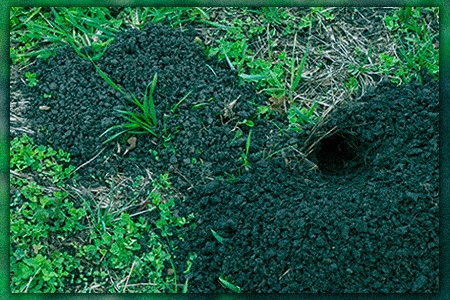
A chipmunk hole is usually 1–2 inches in diameter. You'll find them in any part of your yard, usually near trees, around the foundations of your home, and sometimes in open areas. Take a flashlight and see if you can shine it in the hole to get an idea of their living quarters.
Here's a quick checklist to review. If you notice any of these indicators, you have a chipmunk problem on your hands:
- A 1 to 2-inch holes in the yard
- Chipmunks are seen around the hole
- No dirt piled up around the hole
- The burrow slants down at an angle when viewing it from the surface
It's important to note that if the hole has dirt piled up around it or inside it, chipmunks aren't responsible; it's some other animal. The biggest indicator of a chipmunk hole is that there's no dirt around it. These little critters stuff the dirt in their cheeks as they burrow and deposit it somewhere else, away from the hole.
If you notice dirt around the hole, it's probably a sign of a mole or gopher, not a chipmunk. If the hole is plugged with dirt, it's usually a sign of a gopher. They do this to prevent snakes from entering the burrow. Speaking of, here's how to recognize snake holes in your yard.
How Large Is a Chipmunk Burrow?
Chipmunk holes are one to two inches in diameter but extend some distance under the surface. The average chipmunk burrow varies between 20 to 30 feet in length and 3 feet deep. The burrows also have several exits along their length.
If you find one chipmunk hole in your yard, canvas the surrounding area for signs of other holes. There's no point filling one hole when the rodents have several different options for exiting and entering the burrow.
This is why, when it comes to how to fill chipmunk holes, we're filling the top portions of the entry and exit points and not trying to fill in the entire tunnels. They're simply too long and deep to concern ourselves with.
Will Chipmunk Holes Damage My Yard?
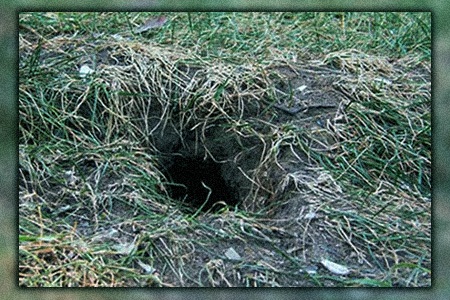
Chipmunks don't damage yards, and sometimes, they'll have already been on your property for weeks or months before you notice the holes. According to the Humane Society, no documented cases of homeowners complaining about chipmunks being destructive in people's yards.
The burrows also contain pockets dug into the sides of the walls where they store food, defecate, and raise young chipmunks. If you don't have a vegetable garden of extensive flowerbeds, having a chipmunk burrow in your backyard might not be such a bad thing.
However, if you don't want these little guys running around your property, so be it. You have the right to prevent them from accessing your yard and digging it up.
How Do Chipmunks Dig Their Holes?
Chipmunks use their arms and legs to do the digging, and they stuff their cheeks with the soil they excavate, removing it from the digging site. They usually dig down at a slanted angle, leveling out the burrow as it gets deeper until it's parallel with the surface above.
There could be several entrances and exits along the burrow's length, and you'll find their nest at the back of the burrow. The pockets created along the way are for storing food, birthing, and toilets.
How to Fill Chipmunk Holes in 3 Easy Ways
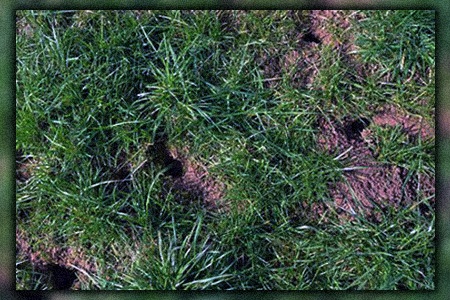
As mentioned, filling in the chipmunk holes with dirt won't do much to deter them from digging it out again. You need a more permeant solution that they can't get through to solve the problem and cause them to move on to another location.
Try one of these three methods for a permanent fix to the problem. Let's look at what to put in chipmunk holes in your yard:
1) Use Gravel to Fill the Chipmunk Hole
You can discourage chipmunks from digging out the hole again by pouring small-stone gravel into the hole. We recommend going with gravel that's around the size of a pea. The gravel shifts as the chipmunks try to remove it, moving further into the burrow.
Chipmunks don't like digging in the gravel; it might have to do with putting it in their cheeks when they try to remove it from the excavation site. Before you start, check around the yard and mark all the chipmunk holes you find. Depending on the size of the chipmunk family living underground, there could be up to six to eight holes nearby the one you find initially.
Pour the gravel into the hole and press it down as far as you can. Keep pouring in the gravel until you pack it as much as possible and it feels firm on the surface. You can use the back of a screwdriver handle to push the gravel as far down into the hole as possible.
Ensure you fill at least the first four to six inches of the hole with as much gravel as possible. Repeat the task for all the other holes you find.
2) Fill the Chipmunk Hole With Sand
Filling the hole with sand isn't ideal. In many cases, the chipmunks will just burrow back through it. It's a minor inconvenience for them, but they've got plenty of time on their hands. If you have to use sand, make sure you pack it as hard as possible into the hole and backfill it with gravel if you can for extra annoyance for these pesky little critters.
3) Use Cement to Cap the Chipmunk Hole
If the chipmunks keep digging out the sand, go to the hardware store and buy a small bag of cement. Mix the cement and fill the hole with sand again, leaving the last 4 to 6 inches empty. Pour the cement into the hole until it's around an inch or two from the surface.
Let the cement cure overnight, and then fill the remainder of the hole with soil. While the chipmunks might manage to get through the sand and perhaps even the gravel, there's no way they're getting through a cement cap. Don't fill the hole all the way to the top with cement, or you're going to have problems when moving your lawn.
The soil buffer between the cement and the surface gives enough space for grass to grow over the hole, or if it's in a bare area, you won't have an identifiable piece of cement on the surface.
Don't Use Pesticides or Chemicals in Chipmunk Holes
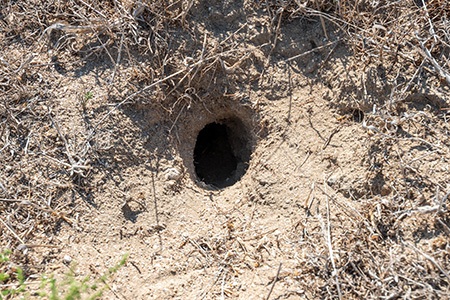
Don't be horrible and pour bleach, pesticides, or other chemicals into the chipmunk hole. In many cases, this strategy makes them die a horrendous, slow, inhumane death. As mentioned, chipmunks won't destroy your yard, so there's no need to try and poison them; they don't deserve that fate.
Sure, chipmunks are technically rodents, but they're very different from rats roaming your property. Leave the little guys alone, plug the holes, and they'll dig themselves out and move on to another location. In most cases, they get the point and find somewhere else to set up shop. We're learning how to fill chipmunk holes, not eradicate them.
And besides, you'll create a lasting negative effect in your lawn if you use those harsh chemicals in the soil where your grass and garden grow their roots down and seek nutrients. They'll soak all that up with the water and it can end up on your dinner plate.
Flooding Chipmunk Holes is a Bad Idea
If you think putting your garden hose into a chipmunk tunnel and turning the water on full blast is going to do anything, it won’t. Not only will the water soak into the soil, but the chipmunks have multiple levels and exits, so they can simply move on to higher ground.
Chipmunks already have plans in place to deal with flooding from heavy rainfalls and the water you pour in isn’t going to affect that. Even if you manage to fill it up with water quickly enough to annoy them, they’ll just escape down another tunnel and out through an exit.
Especially if these tunnels are near the foundation of your home, you don’t want to pour water into them. You don’t want to cause a boggy mess that causes all of the tunnels to collapse all at the same time. This will displace enough soil that it could cause problems for your home.
Mothballs in Chipmunk Holes is Also a Bad Idea
It seems like a good idea. Roll a few mothballs down their tunnels and let the stink run them off. Yes, you’d probably run them off, or if they’re dumb enough they’ll stick around to get poisoned (or even eat the mothballs and really do themselves in).
But what you also risk is your pets digging a mothball up and consuming it, or your kids finding one and playing with it (same reason we don't recommend using mothballs in a room that kids play in). You’ll also end up with a ton of chipmunk corpses rotting in the tunnels, and if you don’t fill them in you’ll get to smell that, too. The same goes with other ideas like using cat litter. Stay away from these “solutions”.
FAQ’s Regarding Chipmunk Holes in Your Yard
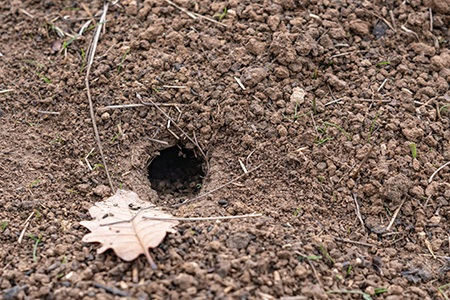
You may be wondering about these three common questions that arise once people start thinking about what to put in chipmunk holes in their lawn. They’re not critical to the task at hand but they are interesting to consider.
How Many Chipmunks Live in a Hole?
Most chipmunks live alone unless it's mating season. If that's the case, you might have a pair of chipmunks living in the burrow and maybe a few of their kids. Chipmunks are somewhat territorial and will chase away other chipmunks using loud chucks and chips to defend their home from invaders.
What Do Chipmunks Do With the Dirt When They Dig a Hole?
Chipmunk holes are unique from other subterranean animals in the sense that they don't pile the dirt they excavate around the entrance to the hole. If you notice this, it means there's another animal responsible for the problem. The chipmunk packs their cheeks with the dirt and spreads it in other locations in the yard.
Do Chipmunks Dig Multiple Entrances to Their Burrows?
A chipmunk burrow can have several entrances along its length. This gives the chipmunk options for escaping if they detect a predator in the burrow as well as escaping from flooding.
Key Takeaways on How to Seal a Chipmunk Hole
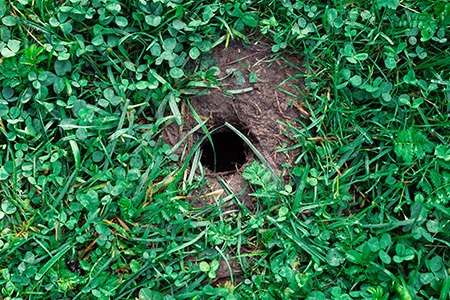
Let’s summarize the most pertinent information from above:
- Chipmunk holes are around 1 to 2 inches in diameter
- There isn't any dirt around the hole
- Burrows can have several access points and are usually 20 to 30 feet in length
- If you notice a chipmunk hole, look around the yard for others
- You can fill chipmunk holes with gravel or sand, but gravel is better
- If the chipmunks excavate the sand or gravel, consider capping the hole with cement
- Don't add poisons or chemicals like bleach to the holes; the chipmunks don't deserve to be poisoned
Chipmunk holes in your yard can be very annoying but other than a small tripping hazard (or a serious one for a small dog that runs around the yard), they don’t pose a major problem. But taking care of them is a good idea if you want to frustrate these little guys enough to send them off to greener pastures. But keeping chipmunks out of your yard is like keeping birds off your porch... good luck!
That’s How to Fill Chipmunk Holes
As you can see, it’s a simple process. You want to fill in their small tunnels and then cap them off at the top with gravel or even a bit of solid concrete. From there it’s very easy to slap some soil across the top and have grass growing once again. How to fill chipmunk holes is simple but it is annoying that we have to get out there and actually do it. Thankfully it’s not very time consuming. Try to have fun!



